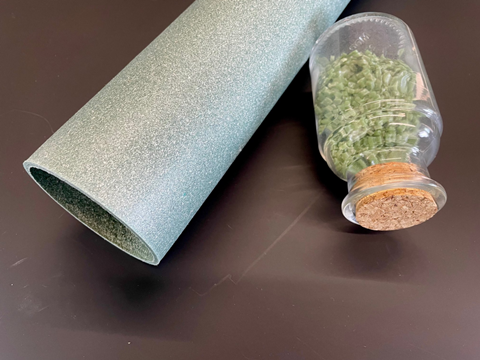
Bausano is using its E-GO R extruder line to turn mixed, post-consumer LDPE and aluminium waste into core tubes in a bid to recycle contaminated plastic waste and align with circular economy principles.
The Packaging and Packaging Waste Regulation mandates that, by 2030, all packaging placed on the European market must be completely recyclable or reusable. Recovering and reprocessing post-consumer plastic waste ‘of unconventional composition’ plays a ‘crucial role’ in achieving this goal, according to Bausano.
Multi-layer packaging like aseptic beverage cartons can be difficult to recycle, Bausano explains. Although they are mostly made of cardboard, the company states that the thin polyethylene and aluminium foils inside the pack – built in to protect the food from contact with external agents – constitute 20% and 5% of the pack, respectively.
Once the pack has been used, its cellulose is extracted and put back into the loop of recycled paper. Meanwhile, the solid PE and aluminium residues become a polyAl compound, with plastic converters driving demand for the material.
At Bausano’s polyAl recovery plant, the material undergoes densification to increase its firmness and ensure it can be further processes. One single-screw extruder for E-GO R 60/37 tubes with double degassing and forced loading system is set to manage the material’s density and ensure that it flows smoothly through the machinery.
The resultant tube is described as ‘robust’ with a ‘smooth surface feel, both internally and externally’. It is recommended for winding reels of cloth, film, and paper, among other materials. Such products are said to lower customers’ environmental impact and costs compared to conventional virgin polymer or cardboard cores.
Bausano uplifts its work method, in which it customizes each extrusion line by taking the customer’s specific formula and working out structured analyses. A feasibility study is carried out prior to the plant design phase, after which the material is analyzed at the company’s laboratory.
A capillary rheometer is used to gauge its viscosity as a function of the shear rate. Bausano’s team uses the rheological characterization of the molten material to design the screw and extrusion head, which is then tested using a Brabender plastograph to predict the cast material’s behaviour during each processing step.
In the case in question, it was able to work out the mixture’s melting speed, rotor torque, and the energy required for the process. It used software for fluid-dynamic analysis to compare the data to the rheological characteristics of materials that are already compatible with extrusion – revealing that the process parameters of the polyAl processed by the customer aligned with the materials already extruded with Bausano technology. This is thought to achieve ‘optimal’ quantity and quality in its output levels.
Bausano can also verify feedback from laboratory instruments in advance and at the company’s site. The last phase involves testing the waste polyAl with a MD30 twin-screw counter-rotating laboratory extruder; this is said to confirm solution’s suitability for industrial-scale up regarding amperage, thrust, and head pressure values.
“Bausano’s distinguishing feature lies in the know-how of its Experts, declined in a consultative and customer-oriented approach,” says Marco Masiero, extrusion test manager at Bausano. “A rigorous process, which qualifies the company as a reference point for the development of innovative solutions capable of satisfying even the most complex production needs, linked to the recovery of non-conventional materials.
“Cutting-edge extrusion technologies, such as those developed by Bausano, open up new horizons in the recycling of post-consumer plastic waste, in favour of an eco-friendly future.”
The news comes after a previous announcement that Tetra Pak and Axjo Group were conducting a feasibility study to build a new recycling plant for the polyAl layers in carton packages. The Gislaved-based plant aims to upscale the recycling of polymer and aluminium layers from carton packaging in Sweden, Denmark, and Norway at a capacity of 10,000 tonnes.
EXTR:ACT e.V and ACE also spoke to us last year, detailing the ways in which the increased collection of laminated paper could benefit material recycling. They suggested that the operational capacity for polyAl recycling at their time of writing was 50 kt/a and believed it would increase yearly, ‘leaving many good opportunities for investors’.
Last October, the 4evergreen alliance’s Circularity Success Stories initiative also awarded SIG for its Palurec PolyAl recycling plant. This facility was launched in Germany by the Fachverband für Getränkekartonverpackungen, commenced its operations in 2021, and produces marketable raw materials.
If you liked this story, you might also enjoy:
How are the top brands progressing on packaging sustainability?
Sustainable Innovation Report 2024: Current trends and future priorities
Reuse vs. single use – which is better for the environment?
The ultimate guide to global plastic sustainability regulation












No comments yet